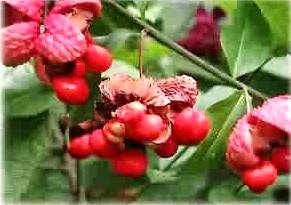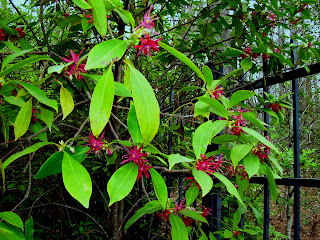
January is a great time for planting here in Georgia! Shrubs and trees planted before the arrival of hot weather have a much better chance of surviving the drought. I’m afraid it’s time we all adjust our gardens for the return of the drought each year.
Several years ago, our garden was certified as a Wildlife Habitat by the National Wildlife Federation. We are very proud of that, because preserving our environment for wildlife and our children is very important to my family and me.
Not only is preserving wildlife and native plant species important from an environmental standpoint, but native plants are easier to grow, since they are able to thrive in our climate!
In addition to being easy to grow, many of our Native American Species offer other advantages over the imported counterpart.
Consider American Euonymus with the unusual red fruits instead of the more common Euonymus that is invasive. The fruit resembles a hard strawberry until the capsule bursts open to reveal bright orange seeds—food for the birds! (See the photo above.)
American Native Azaleas perfume the garden with a lovely fragrance, while Asian Azaleas have no fragrance at all! And what could be more beautiful than a native azalea in full bloom?
Nothing smells sweeter than the banana-pineapple scented blooms of the native Sweetshrub, Calycanthus floridus.
The bright red blooms of our American native honeysuckle vine, Lonicera sempervirens, will attract whole families of hummingbirds, yet won’t take over and pop up all over the community as does the very aggressive Japanese honeysuckle.
So as you add new plants to your garden during this great planting time, seek out some of these rare native specimens, and don't be afraid to plant them now, to give them a headstart before summer! And check back soon for suggestions on how you can improve your garden to help protect your local wildlife.
For more information on these and other plants for your garden, please visit Shady Gardens Nursery.



















